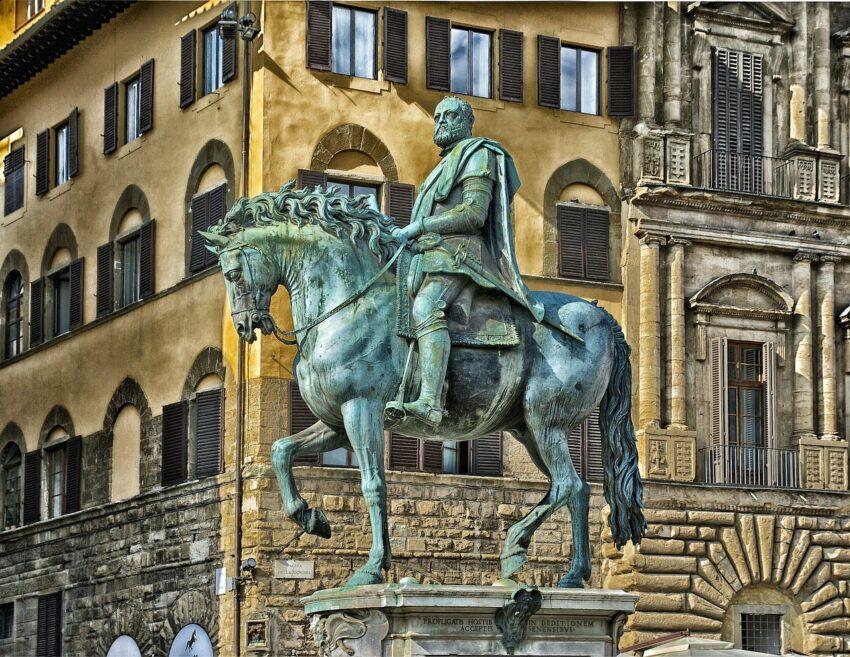Medici – The Rulers of Florence: A Dynasty of Influence and Art
Medici: Often hailed as the most influential family of the Renaissance, the Florentine dynasty left an indelible mark on the history of Florence and beyond. Their power extended not only into politics but also into economics, art, and science, creating a legacy that continues to be celebrated.
Medici: Origins and Rise
The influential clan originally hailed from Tuscany, rising to prominence in the 14th century as wealthy bankers. Giovanni di Bicci, regarded as the founder of the family fortune, laid the groundwork for the Medici Bank, which soon became one of the most important financial institutions in Europe. His son, Cosimo the Elder, elevated both the family business and Florence to great prosperity and renown.
Political Influence
Cosimo the Elder and his descendants ruled Florence in practice, although the city was officially a republic. Their influence was based less on official titles and more on shrewd diplomacy, strategic marriages, and financial power that gave them control over the city’s key institutions. Lorenzo the Magnificent led the family to the height of its influence in the 15th century, turning Florence into a center of Renaissance culture under his reign.

Patronage of Arts and Culture
The rulers of Florence were not just politicians and bankers but also great patrons of the arts and sciences. They supported artists like Michelangelo, Leonardo da Vinci, and Sandro Botticelli, contributing to the creation of numerous masterpieces that are still admired today. Lorenzo the Magnificent was himself a poet and a passionate collector of ancient artworks.
Their patronage extended to science as well. Cosimo I established the Accademia del Disegno, the first art academy in Europe, and promoted scientific studies that contributed to the development of modern science. Galileo Galilei, one of history’s most significant scientists, was supported by the family and named four of Jupiter’s moons after them.
Decline and Legacy
Despite their impressive rule, the Florentine dynasty also faced periods of decline. Internal disputes and external threats led to phases of lost power. In the 18th century, the main line of the family ended with the death of Gian Gastone.
However, their legacy endures. Their support of the arts and sciences played a crucial role in the flourishing of the Renaissance and left a cultural heritage still evident in the streets and museums of Florence. The Uffizi Gallery, one of the world’s most renowned art museums, was founded by the family and houses many masterpieces they sponsored.
Recommended English Literature on the Medici
For those interested in delving deeper into the history and impact of this illustrious family, the following books provide comprehensive and engaging insights:
“The House of Medici: Its Rise and Fall” by Christopher Hibbert
This book offers a thorough and vivid account of the family’s ascent to power and their eventual decline, highlighting the key figures and events that shaped their legacy.
“Medici Money: Banking, Metaphysics, and Art in Fifteenth-Century Florence” by Tim Parks
Parks provides an engaging exploration of how the family’s financial acumen influenced the cultural and political landscape of Florence, blending historical analysis with storytelling.
“The Medici: Power, Money, and Ambition in the Italian Renaissance” by Paul Strathern
Strathern’s book delves into the complex web of power, wealth, and ambition that defined the family’s rule, offering detailed portraits of its most famous members.
“Magnifico: The Brilliant Life and Violent Times of Lorenzo de’ Medici” by Miles J. Unger
Focusing on Lorenzo the Magnificent, this biography paints a vivid picture of his life, his contributions to the Renaissance, and the turbulent times he navigated.
“Medici Women: The Making of a Dynasty in Grand Ducal Tuscany” by Giovanna Benadusi
This book highlights the often overlooked contributions of the women in the family, shedding light on their roles in shaping the dynasty and their cultural and political influence.
“The Medici Effect: What Elephants and Epidemics Can Teach Us About Innovation” by Frans Johansson
Although not a historical account, this book draws inspiration from the family’s ability to foster innovation by bringing together diverse fields of expertise, offering lessons applicable to modern-day creativity and business.
These works provide a rich tapestry of the Florentine family’s influence, offering readers a deep understanding of how their patronage and politics left a lasting mark on history.
